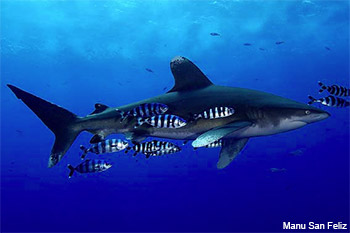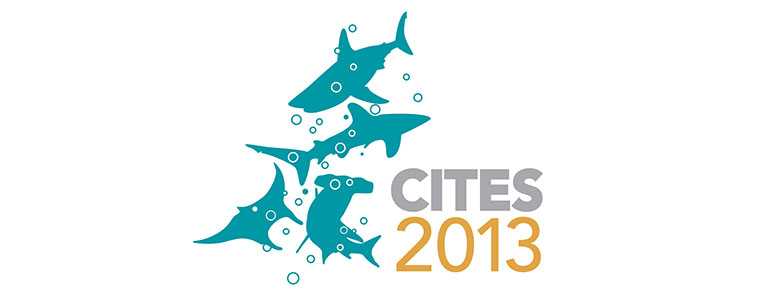CITES 2013: Oceanic Whitetip Shark
Sponsored by Brazil, Colombia, and the United States
Species Information
The oceanic whitetip (Carcharhinus longimanus) is an open-ocean species with a distinctive white tip on its dorsal fin. Although it is one of the most widespread shark species, found throughout the world's tropical and temperate seas, it is also one of the most threatened.
Oceanic whitetip sharks have experienced signifi cant population declines due largely to overexploitation fueled by a global demand for their large, highly valued fins. They are assessed by the International Union for the Conservation of Nature (IUCN) Red List of Threatened Species as critically endangered in the northwest and western central Atlantic Ocean and as vulnerable globally. In addition, the oceanic whitetip falls into the United Nations Food and Agriculture Organization's (FAO) lowest productivity category, meaning that it has an extremely low reproductive capacity, making it particularly vulnerable to overexploitation. It is also one of the ocean's most vulnerable species.
Several scientific studies document the drastic decline in this shark's populations. One population study in the Gulf of Mexico estimated a drop of 99 percent in just four generations. In the northwest Atlantic, an analysis showed declines of up to 70 percent since 1992. A similar analysis in the Pacifi c estimated a 90 percent decline in biomass.19 Most recently, a 2012 stock assessment in the western and central Pacific Ocean determined that oceanic whitetip sharks were overfished and that overfishing is occurring.
Several targeted fisheries exist for oceanic whitetips, which are also frequently caught as bycatch in tuna and swordfish fisheries. Although this species experiences a high catch-survival rate on longline fishing gear and could be released alive, the low market value of its meat coupled with the high value of its fins often leads fishermen to instead remove the fins at sea and dispose of the carcass overboard.
Oceanic whitetip fins are easily identified in trade by the white tips, rounded shape, and large size, making them one of the most distinctive products in the shark fin trade. Identification of these unprocessed fins can be done by visual observation alone, with a DNA study of fins showing that fin traders can identify oceanic whitetip fins with 100 percent accuracy. These sharks make up approximately 1.8 percent of the identifi ed fi ns entering the Hong Kong market. From this information, scientists have estimated that 250,000 to 1.3 million oceanic whitetips are killed worldwide per year for the fin trade.
Oceanic whitetips are receiving some protection through recently agreed conservation and management measures by some regional fisheries management organizations (RFMOs). But these measures do not extend to the full range of the species, nor do they regulate international trade. Furthermore, these measures apply only to oceanic whitetip sharks taken in the specific fisheries covered by those particular RFMOs and only to the governments that are members of those RFMOs. Three regional fisheries management organizations—the International Commission for the Conservation of Atlantic Tunas, the Inter-American Tropical Tuna Commission, and the Western and Central Pacifi c Fisheries Commission—have prohibited the retention onboard, transshipment, and landing of oceanic whitetip sharks within their fisheries.
Benefits of a CITES Listing
A proposal to include the species in Appendix II was proposed at the 15th meeting of the Conference of the Parties (CoP15) and was endorsed by the FAO, the CITES Secretariat, and TRAFFIC/IUCN. However, at that time, the proposal was narrowly rejected. Although RFMOs have taken some conservation and management actions since CoP15, huge gaps in regulations remain, and enforcement and compliance are limited. Including oceanic whitetips in CITES Appendix II will help States enforce their domestic prohibitions and help contracting Parties to relevant RFMOs ensure compliance with existing management measures. An Appendix II listing is scientifi cally justifi ed and essential to ensure that trade occurs only from legal and sustainable fi sheries, and it would help facilitate data collection across the species' range.












